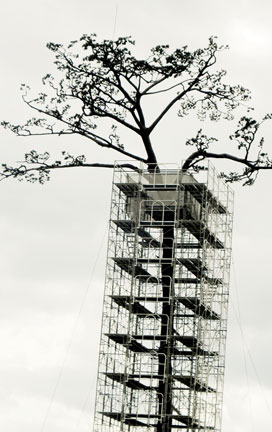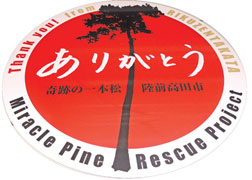|
Miracle Pine Tree:
Symbol of hope for Japan
By Pramod De Silva
Desolation and destruction. These were the only two words that came
to my mind as I was driven through the ruins of Rikuzentakata, Iwate
Prefecture, one of the areas hardest hit by the March 11, 2011 tsunami
in Japan.
 |
|
The Miracle Pine Tree with the steel
structure which supported it |
 The city, on Japan’s northeast coast, is now being reconstructed
under a massive project that will see the elevation of the city centre
to a point where a tsunami would not cause any damage. I visited the
area exactly two years after the destructive tsunami, but debris was
still scattered everywhere as buildings stripped to their shells stood
silently in the cold wind blowing in from the sea – the very sea that
turned violent, taking nearly 2,000 lives in Rikuzentakata. The city, on Japan’s northeast coast, is now being reconstructed
under a massive project that will see the elevation of the city centre
to a point where a tsunami would not cause any damage. I visited the
area exactly two years after the destructive tsunami, but debris was
still scattered everywhere as buildings stripped to their shells stood
silently in the cold wind blowing in from the sea – the very sea that
turned violent, taking nearly 2,000 lives in Rikuzentakata.
The city officials who accompanied me showed me something that had
withstood the fury of the tsunami even as everything around it was swept
away. Our car stopped at the end of a construction site and they pointed
to a tree - yes, a tree - that had somehow miraculously survived the
onslaught of the waves. “That is the Miracle Pine Tree,” they echoed in
unison.
Face of adversity
The Miracle Pine Tree has become a symbol of hope, not just for
Rikuzentakata, but for all of Japan, still recovering from the East
Japan (Tohoku) Earthquake and Tsunami. While nearly 70,000 other pine
trees (and everything else around them) were consumed by the waves, this
Miracle Tree literally stood its ground, becoming a symbol of resilience
in the face of adversity.
The stand of pines, known as the Takata Matsubara, or pine forest,
lined Rikuzentakata’s long, white-sand beach. It was the city’s main
tourist attraction. Its beauty drew visitors from across Japan and even
overseas, providing vital income for the local economy.
City officials and residents were engaged in a race against time to
preserve the last tree left of the pine forest. The Miracle Pine Tree,
also known as the Lone Pine, has become a beacon of hope to the people
of Japan, who have contributed in their thousands to the worthy cause of
preserving it for posterity.
Miraculously, the only other structure that remained intact after the
waves receded was the city’s primary school just across the water from
where we stood. Not surprisingly, local students have taken a major
interest in reviving the tree. Coincidentally, just behind the school is
a similar pine grove.
A team of volunteer specialists has put the tree on the arboreal
equivalent of life support, wrapping its trunk in bandages and
constructing a caisson around its base in an effort to keep the
infiltrating sea at bay. A steel structure which surrounded the tree for
additional protection has now been removed as the tree can stand on its
own with alternations and reinforcements to its trunk.
Barricade for protection
Botanists built a sandbag-and-timber barricade to protect the pine
against the ocean and salt water. Gashes in the tree’s bark were treated
with antibiotics and its trunk was wound with straw and green plastic.
Straw mats were laid to protect the tree’s shallow roots. Workers used a
pile driver to slam interlocking steel plates 16 feet deep into the
earth around the tree. Salt water was pumped out while tons of fresh
water were poured in.
The Lone Pine has been adopted as Rikuzentakata’s unofficial emblem,
and its image adorns everything from towels and T-shirts to the helmets
of soldiers conducting relief operations. Posters feature a photograph
of the tree and an exhortation: “Join our hearts together, and let’s
bring our hometown back to life.”
|

The primary school, which also survived the tsunami. Top,
the unofficial emblem of Rikuzentakata |
|

Debris is still scattered everywhere in Rikuzentakata
Pix: Pramod de Silva |
As I stood gazing at the tree, it was not difficult to comprehend why
it gives the Japanese people hope for a brighter future. Here was a
creation of Nature itself that was not swayed by the fury of another
creation of Nature. As the saying goes, if there is a will, there is a
way.
City officials are not taking any chances, however. To preserve the
27-metre high Lone Pine’s DNA, scientists have taken cuttings of
branches and grafted them on to the trunks of similar pines. Eighteen
saplings of the pine tree are growing at a research institute in Ibaraki
Prefecture. The saplings were nurtured from seeds taken from pine cones
of the tree.
“We hope the saplings that have inherited the lineage of the solitary
survivor will contribute to the recovery efforts (in the Tohoku
region),” said a researcher at Sumitomo Forestry Co.’s Tsukuba Research
Institute, where the saplings are growing.
Cloning techniques
In addition to the 18 saplings, a company affiliated to Sumitomo
Forestry has bred three different seeds using cloning techniques
involving grafting. Those saplings are now being raised on farmland in
Saitama City. This may be the start of attempts to re-grow the
two-kilometre long pine forest which is believed to have been around 350
years old. However, it will take many decades for that to happen.
Tourists from all over Japan (and a few curious foreign visitors) are
again visiting the site - this time to pay homage to the Pine Tree.
There is a small museum-cum-shrine which they visit before heading for
the Pine Tree and surveying the damage.
The site will be formally opened to the public as soon as work on the
tree is completed. The tree will be preserved as a ‘living sculpture’
and a symbol of hope for the people of Japan. It does not have any real
leaves as such, with plastic ones taking their place.
Rikuzentakata city officials plan to plant a lawn and erect a flower
altar around the restored tree. The ceremony to mark the project’s
completion, at a cost of US$ 1.6 million, will be held on July 3. The
tree will be lit up each day until 9:00 p.m. to showcase its stunning
restoration, and will continue to be lit for an year.
Although the city fathers drew some criticism for the enormous cost
involved, most residents agree that it was a worthy effort to preserve a
symbol of Iwate’s resilience in the face of the biggest natural disaster
to hit Japan in recent history.
(The writer’s trip to Iwate Prefecture was organised by the Ministry
of Foreign Affairs of Japan) |


